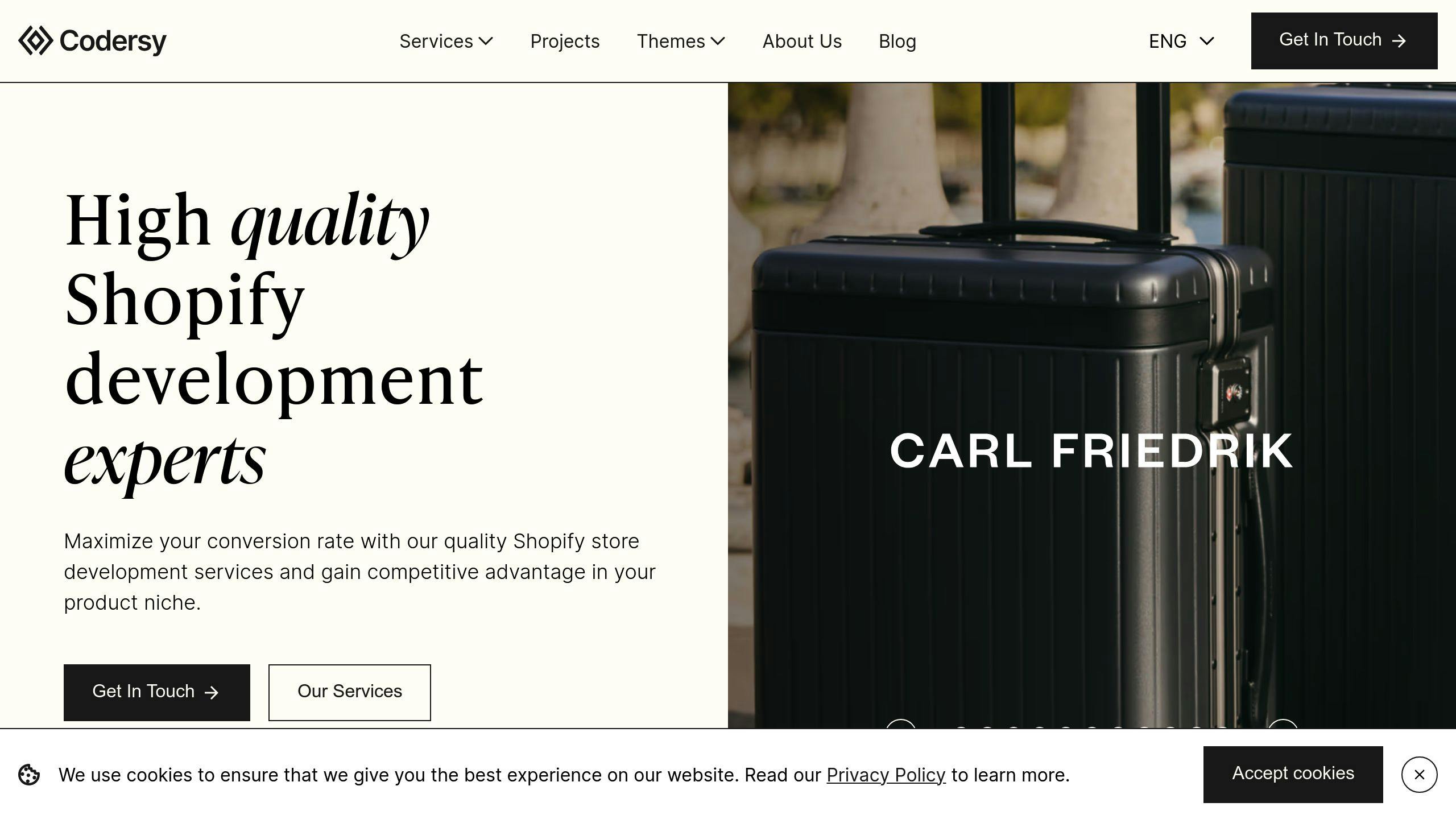By Mladen Terzic
Shopify SEO Updates
25th May 2025
5 min read
Ultimate Guide to Shopify Image SEO
Learn how to optimize Shopify images with descriptive filenames, ALT text, compression, and advanced tactics like schemas and lazy loading.

Want to boost your Shopify store's performance? Start by optimizing your images. Here's how image SEO can help:
- Faster Load Times: Compress images to speed up your site.
- Better Search Rankings: Use descriptive file names and ALT text with keywords.
- Improved User Experience: Ensure accessibility and smooth browsing with techniques like lazy loading.
Quick Tips:
- Rename files to something like
blue-cotton-shirt.jpg. - Write ALT text like "Men's blue cotton polo shirt."
- Compress images under 70 KB using tools like TinyPNG.
For advanced strategies, consider structured data, image sitemaps, and Shopify apps like TinyIMG. These steps can improve visibility, conversions, and overall site performance. Ready to dive in? Let’s explore!
Shopify Images Tutorial for Speed & SEO
Key Steps for Optimizing Shopify Images
Optimizing your Shopify product images is a straightforward way to boost your site's SEO and improve user experience. Here's how to do it effectively:
Using Descriptive File Names
Choose file names that are clear, concise, and include keywords related to the product. Stick to lowercase letters and use hyphens to separate words. For example, a good file name could be: "blue-cotton-mens-polo-shirt.jpg". This makes it easier for both search engines and users to understand what the image represents.
Writing ALT Text for SEO and Accessibility
ALT text serves two purposes: helping search engines understand your images and making your site accessible for those using screen readers. Write ALT text that is descriptive and naturally integrates keywords.
For example:
- Instead of generic terms like "shirt" or "DSC12345", go with something like: "Men's Blue Cotton Polo Shirt with Short Sleeves."
- Or: "Handcrafted Leather Wallet with RFID Protection."
Compressing Images to Improve Speed
Page load speed is critical, and large image files can slow things down. Compress your images to keep them under 70 KB while maintaining good quality. Use formats like JPEG for photos or WebP for modern browsers [2]. Remember, even a one-second delay in loading can negatively impact conversions.
Once you've nailed these basics, you can explore more advanced strategies like adding structured data or implementing lazy loading for further optimization.
Advanced Techniques for Shopify Image SEO
Once you've mastered the basics, you can take your Shopify store's image SEO to the next level with strategies like structured data, image sitemaps, and lazy loading. These methods can help improve both your site's performance and its visibility in search results.
Adding Structured Data for Images
Structured data, like schema markup, helps search engines better understand your content. For images, this can mean showing product images, prices, and availability directly in search results. Adding this extra layer of information can make your store's listings stand out.
For product images, use the 'Product' schema type. Tools like Google's Structured Data Markup Helper or apps like JSON-LD for SEO in Shopify simplify this process. Here's a simple example of schema markup for a product:
{
"@context": "https://schema.org/",
"@type": "Product",
"name": "Blue Cotton Polo Shirt",
"image": "https://store.com/blue-cotton-polo-shirt.jpg"
}
Building and Submitting Image Sitemaps
Image sitemaps ensure that search engines can find and index all your product images. They also provide extra details, like titles and descriptions, which can boost your SEO efforts.
To create an image sitemap:
- Use tools like Screaming Frog SEO Spider to generate one.
- Include details like image titles, captions, and license information.
- Submit the sitemap through Google Search Console to speed up the indexing process.
Using Lazy Loading for Faster Pages
Lazy loading delays image loading until they're about to appear on the user's screen. This improves page speed and creates a smoother browsing experience. Many Shopify themes already support lazy loading, but you can enhance it further with custom code or apps. Use the loading="lazy" attribute or JavaScript for broader compatibility.
"Lazy loading can help reduce the initial page load time and improve user experience by allowing customers to interact with the page more quickly. Additionally, lazy loading can help reduce bounce rates by ensuring that customers are not waiting for images to load before they can view the content." [1]
sbb-itb-6dc743d
Tools to Help with Shopify Image SEO
Optimizing images for SEO doesn't have to be complicated - especially when you have the right tools. Both Shopify-specific apps and external tools can simplify the process and boost your store's performance.
Shopify Apps for Image Optimization
Here are two Shopify apps that can make image optimization easier:
- TinyIMG ($4.99/month): This app automatically compresses images and converts them to WebP format, ensuring faster load times and compatibility across devices.
- StoreSEO ($9.99/month): A great choice for managing image metadata and conducting in-depth SEO audits to improve your store's visibility.
| App | Feature Highlight | Price |
|---|---|---|
| TinyIMG | WebP Conversion | $4.99/month |
| StoreSEO | SEO Auditing | $9.99/month |
External Tools for Image SEO
If you're looking for advanced features, these external tools are worth considering:
- Screaming Frog SEO Spider: This tool helps you find missing ALT text, oversized images, and broken links. It's a powerful auditing tool priced at £149/year.
- Google Image Sitemaps Generator: A handy tool for creating and managing sitemaps, ensuring your images are indexed effectively when used with Google Search Console.
These tools complement strategies like using structured data and sitemaps, helping you maximize your Shopify store's visibility. For even better results, working with Shopify experts can provide tailored solutions for your store's specific needs.
Working with Experts to Improve Shopify Image SEO
Shopify experts can tackle both technical and strategic challenges related to image SEO, helping your store improve search rankings and engage users more effectively. With their help, you can skip the trial-and-error process and get results faster.
Custom Themes with Built-In Image Optimization
Custom Shopify themes come equipped with advanced features like lazy loading, WebP conversion, and responsive image handling. These tools are integrated directly into your store, automating much of the optimization work. This reduces the need for manual adjustments and keeps maintenance simple for store owners.
Technical SEO for Image Optimization and Speed
Experts focus on improving performance in key areas that directly impact your store's speed and visibility:
| Service Type | Description |
|---|---|
| Core Web Vitals Optimization | Improves metrics like LCP (Largest Contentful Paint) and CLS (Cumulative Layout Shift) for better rankings and user experience. |
| Image Delivery Network Setup | Ensures faster image loading across the globe, boosting performance. |
| Structured Data Implementation | Adds important context to images, increasing visibility in search results. |
Codersy: Shopify Development Services

Codersy specializes in Shopify solutions tailored to your needs. Their services include custom themes, technical SEO, and page speed optimization. They handle advanced techniques like lazy loading, WebP conversion, and structured data, ensuring these features are implemented correctly and efficiently. This not only saves time but also helps avoid common mistakes.
Summary and Next Steps
Key Takeaways
Optimizing images plays a crucial role in improving search rankings and site speed. Before moving forward, let’s recap the essential elements that contribute to effective image SEO:
- File Names and ALT Text: Use descriptive, keyword-focused file names and ALT text. This helps search engines understand your images while ensuring accessibility.
- Technical Optimization: Striking the right balance between image quality and speed enhances your site's performance. Here's how specific optimizations can make a difference:
| Optimization Factor | Effect on Performance |
|---|---|
| Compressed Images | Cuts page load time by 50–70% |
| Lazy Loading | Trims initial load time by 30–40% |
Now that the basics are clear, let’s dive into actionable steps to put these strategies into practice.
Next Steps to Take
- Audit Your Images: Check file names, ALT text, and image sizes. Use tools like Google Analytics to measure your site's current performance before making changes.
- Implement Technical Enhancements: Add structured data and create image sitemaps for better optimization. Consider using tools or professional services to enable WebP conversions and responsive image handling in your store's theme.
- Track and Refine: Monitor page speed and search rankings using analytics tools. Adjust your approach based on performance data, and stay informed about emerging best practices to keep your site competitive.
FAQs
How to optimize an image in Shopify?
Optimizing images in Shopify improves both your site's search engine visibility and how users experience your store. Start by resizing images to fit display dimensions – Shopify suggests 800 × 800 pixels for zoomable product images [2].
Here’s how you can do it:
- Pick the right format: Use JPEG for photos and PNG for graphics with transparency.
- Compress the file size: Tools like TinyPNG or ShortPixel can help reduce image size without losing quality.
- Use SEO-friendly file names: Rename your files to reflect keywords (e.g., "red-leather-crossbody-bag.jpg").
- Add descriptive alt text: Write short, keyword-focused alt text for better accessibility and SEO.
These steps help your images load faster while maintaining quality. Next, let’s look at managing image sizes.
How to optimize image size for Shopify?
Keeping image sizes small is key to faster page loads without sacrificing quality. Aim for file sizes under 70 KB for the best performance [2].
| Optimization Method | File Size Reduction | Best Use Case |
|---|---|---|
| JPEG Compression | Up to 90% smaller | Product photos |
| PNG Optimization | 50–70% smaller | Transparent graphics |
| WebP Conversion | 25–35% smaller than JPEG | Faster-loading stores |
To make this process easier:
- Automate with Shopify apps: Use tools like TinyIMG or Crush.pics for quick resizing and compression.
- Do it manually: Tools like ImageOptim let you batch-process images before uploading.
- Choose the right format: Use WebP for modern browsers and keep JPEG/PNG as backups. Combine this with lazy loading to further improve performance.



